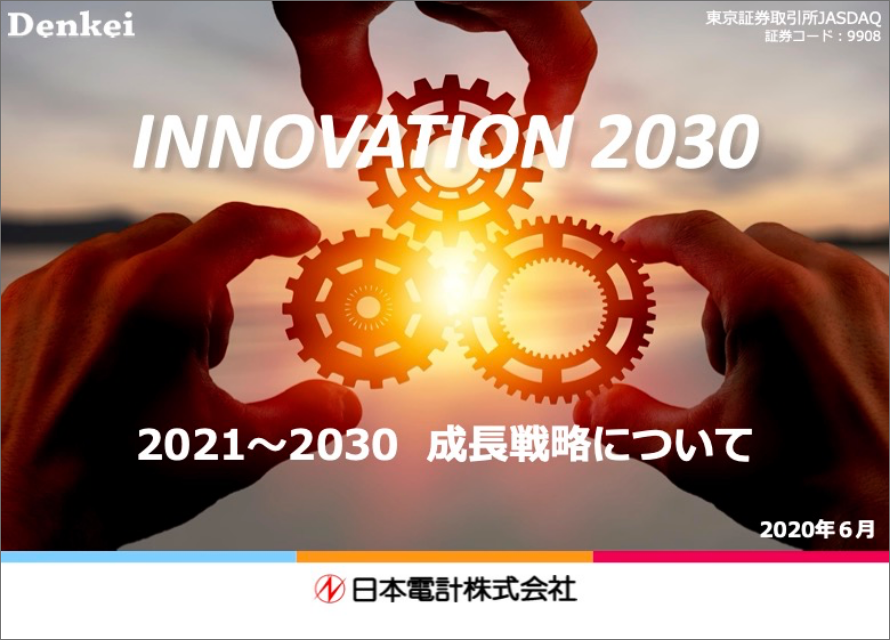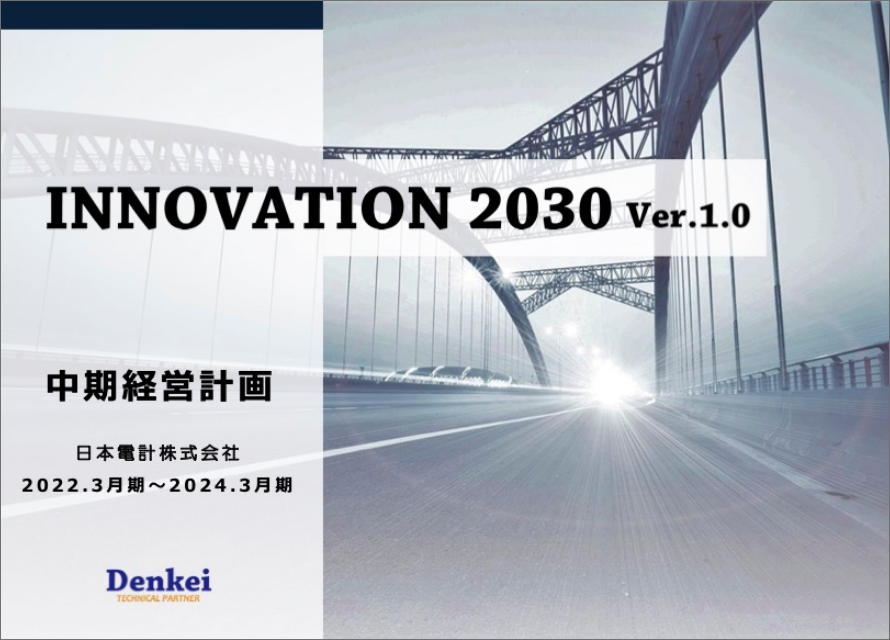History of Nihon Denkei
We will introduce our history for the half-century from 1950.
We will omit the specific name of the corporations in this text.

Founded in 1950
Yoshinobu Takada founded the company with capital of JPY 0.3 million
The year 1950 was the first year of the Korean War. This was also the year of the “gold-biased economy,” in which the economy was booming with the emergence of special demand and the rapid increase in exports. Although five years had passed since the end of World War II, our society had not yet settled down. Under these social circumstances, on September 4, 1950, Nihon Denkei Co.,Ltd. was born on 1-28 Kanda-Suda-cho, Chiyoda-ku, Tokyo. It was located at the corner of the Kanda-Sudacho intersection just in front of the streetcar stop coming from Ginza.
Starting the business as a used goods seller
The business office in Kanda Suda-cho was used as a store on the first floor and an office on the second floor with just one desk. The third floor was used as storage. In the store portion of the first floor, a glass-made showcase was placed at the entrance facing the road and a shelf was made for displaying goods on the wall at the back of the store. Though the company was established, the city was not in a position to produce new products in the scorched earth all around. Therefore he purchased used goods that remained in the district where the air raid was avoided, took them back to urban areas and sold them after repair (i.e. selling used goods). At that time Akihabara was in the process of being established as an electric city where there were many open-air shops using 2-wheeled carts. The shopping area was crowded with customers who came to buy parts and products from electric-related companies every day. The shops started to open the 2nd of January and kept on opening (even on Saturdays and Sundays). It was a time when goods could be sold right away due to a shortage of materials and the booming economy. In 1950, only four companies, including us, sold measuring instruments and junk products in Kanda. At the time, teachers from the University of Tokyo, Chuo University, Nihon University, and Tokyo Electric University were coming to buy measuring instruments with cash.
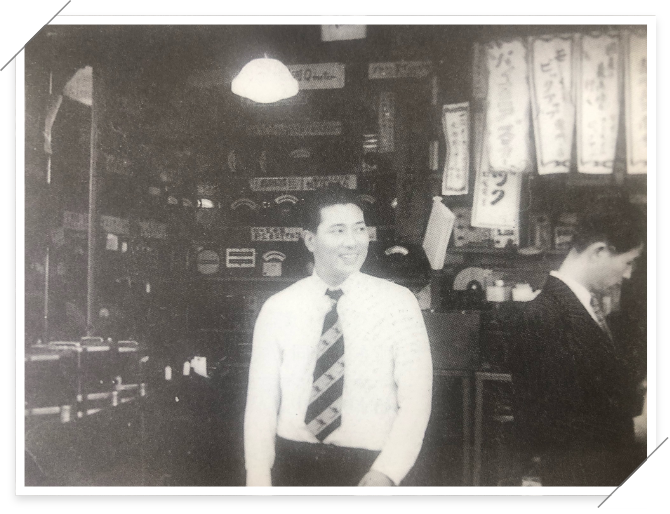
Yoshinobu Takada, the founder, standing in front of his store in Kanda-Suda-cho
Commencement of delivery services
Around 1954, among the numerous products purchased by each university, he started a delivery service for heavy product. As deliveries to Tokyo Tsushin Kogyo (currently Sony Corporation) increased, full-scale delivery services began. At the time deliveries were carried by hand while often walking after arrival at a railway station close to the place of delivery. Typical deliveries were heavy products that were tied with rope that required brief rests, stopping to place the goods on the ground when hands became too painful. It was in August, 1955 when the company’s employees became licensed and began delivering goods by vehicles often called “ex-taxis”, second-hand reconditioned taxis repainted and used as delivery cars for Nihon Denkei.
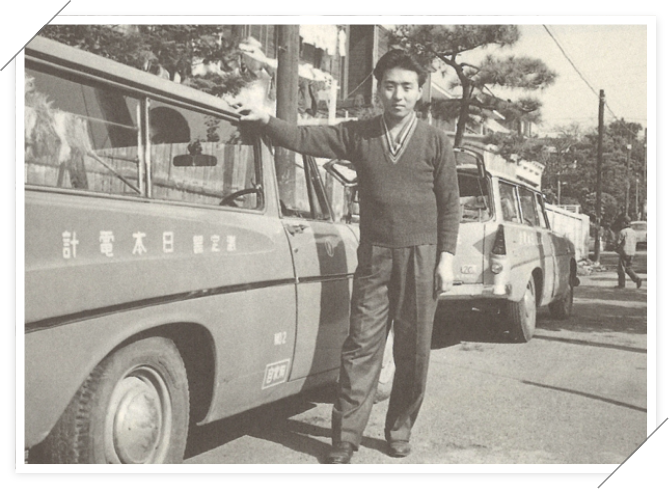
Prince Motor’s “Skyway”, which was purchased as “ex-taxi”
10% trading firm
Trading firms generated profit from gaps between the purchase price of goods and the sell price. The larger the difference the more prosperous the company. The sale of measuring instruments generated only around 10% of gross profit, which compared poorly to other trading firms.Therefore, we were mocked as a “10% trading firm.” However, the founder, Yoshinobu Takada, did not seek fortune with a single stroke. He was a tireless worker with an unwavering discipline of “look before you leap”; contrary to the conventional “rushing recklessly” way of doing business at the time.
Days aiming to be a distributor
In the first five or six years after the company’s foundation most of its sales came from schools such as the Faculty of Engineering at Tokyo University. However, as the salesforce grew, business with customers other than schools increased. Throughout the company it became clear anything related to measuring instruments could be handled by us as a trusted trading firm. Consequently, the volume of handling products and customers had increased. Major products that we sold at that time were Matsunaga Corporation “Slidac(voltage regulators)”, Yamabishi Electric Co., Ltd. power supply equipment, and Matsushita Electric Industrial Co., Ltd., Kikusui Electronics Co., Ltd. and Iwasaki Communication Machinery Co., Ltd. oscilloscopes. As a trading firm, we aimed to become a distributor officially authorized by manufacturers to sell their products. As a trading firm specializing in electronic measuring instruments, Nihon Denkei, which started from a junk shop, climbed to the top position in the industry.
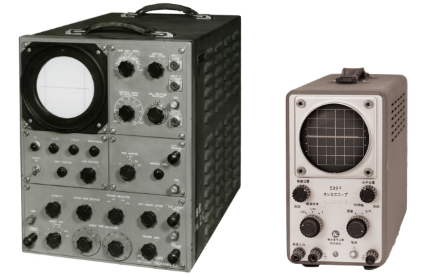
Left: Iwasaki Communication Equipment SS-1251A Synchroscope
Right: Kikusui Electronics 539F Oscilloscope

Sowing each seed with love
In 1960, the Japanese economy entered a period of its first high growth era. While all companies in Japan were trying to make a leap forward getting on the updraft the government announced its plan to double income as private-sector capital investments increased tremendously . In the tailwind of this era, we were also riding the wave of development. Among the products we handled, the sale of synchroscope, in particular, had grown in a striking manner. In the first decade since its foundation, the company had also experienced a significant leap forward. In May 1960, it established Iwasaki Synchroscope Sales Co., Ltd. through a joint investment with Iwasaki Telecommunication Machinery Co., Ltd. At that time, the number of suppliers handled by us increased sharply and the number of users expanded not only in Tokyo but also throughout the entire Kanto region.
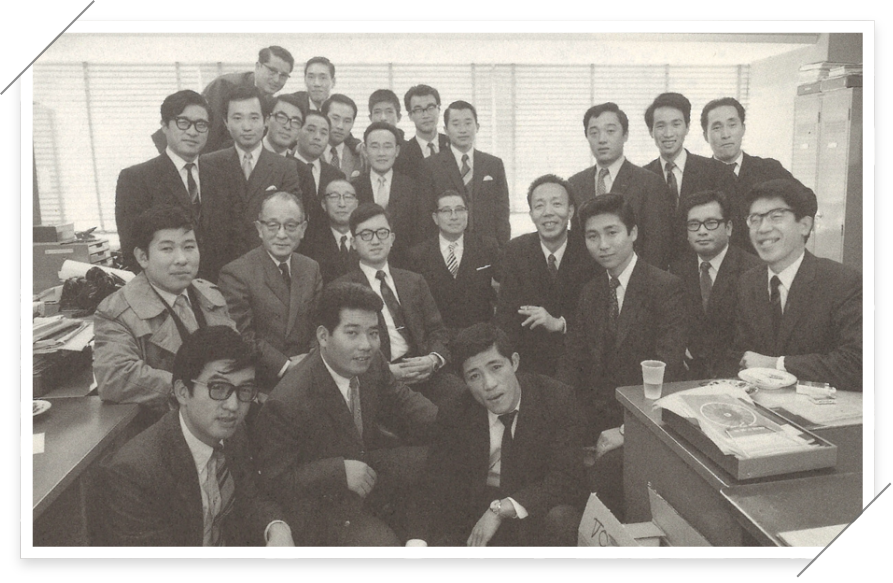
Employees of Iwasaki Synchroscope Sales Co., Ltd.
Development of bases closely linked to local communities
High-quality after-sales service is a lifeline for distribution business. As the number of users grew expectations for us went through the roof. Since we were required to respond more quickly, we have began to open community-based sales offices, which to this day is our current business model.
Industry’s first caravan vehicle
When caravan cars didn’t yet exist, salespersons were distributing manufacturer catalogs directly to users to receive orders. While the number of manufacturers and products we handled increased, various types of catalogs increased as well. Therefore, at the same time as distributing the catalog, we loaded the product on a sales vehicle called a “caravan vehicle” to call on users throughout. We were the first in the industry to use a caravan vehicle. The car we used was a Nissan “Echo” microbus modified by an automobile manufacturer named Kanto Auto Body. The salesperson would take a ride on the bus and call on users in Ibaraki and Tochigi Prefecture, staying overnight at an inn while visiting for two or three days.
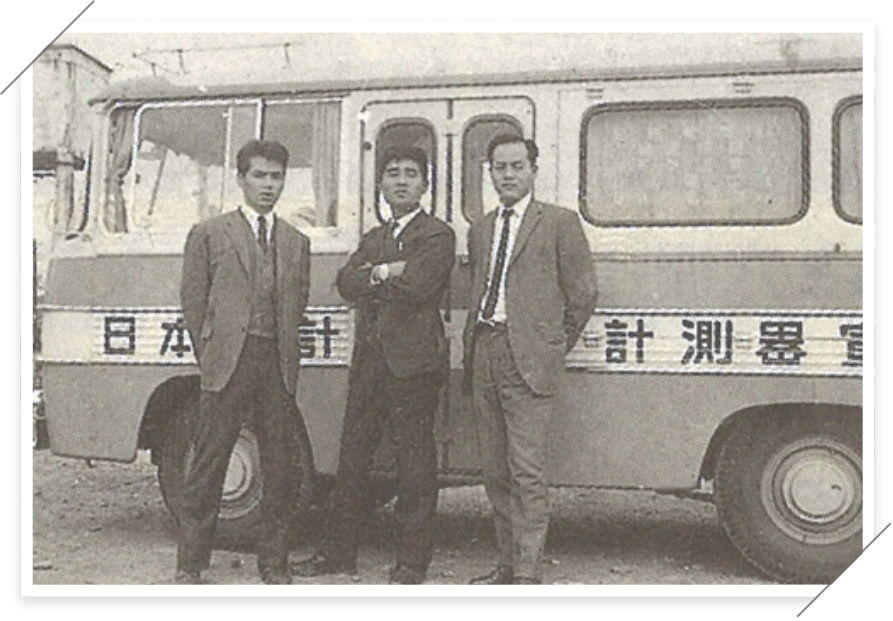
Industry’s first caravan vehicle with products loaded
Rushing delivery hours to engineering high schools and private universities
After WWII, a great number of children were born as the so-called baby boom generation reached high school age. With the Industrial Education Promotion Law, (promulgated by the Ministry of Education in 1951 for industrial/engineering education) the establishment of new engineering high schools in each prefecture reached a peak. Manufacturers were busy producing measuring instruments for experiments based on the Industrial Education Promotion Law. Meanwhile we continued to deliver products on behalf of manufacturers day in day out.
Relocation of head office
The head office building located at the corner of Kanda-Suda-cho (which we leased when the company was founded) originally had only 5 sq.meter of space, enough office space for only six or seven people.
In May 1969, the head office was relocated to Ueno, Taito Ward, Tokyo.
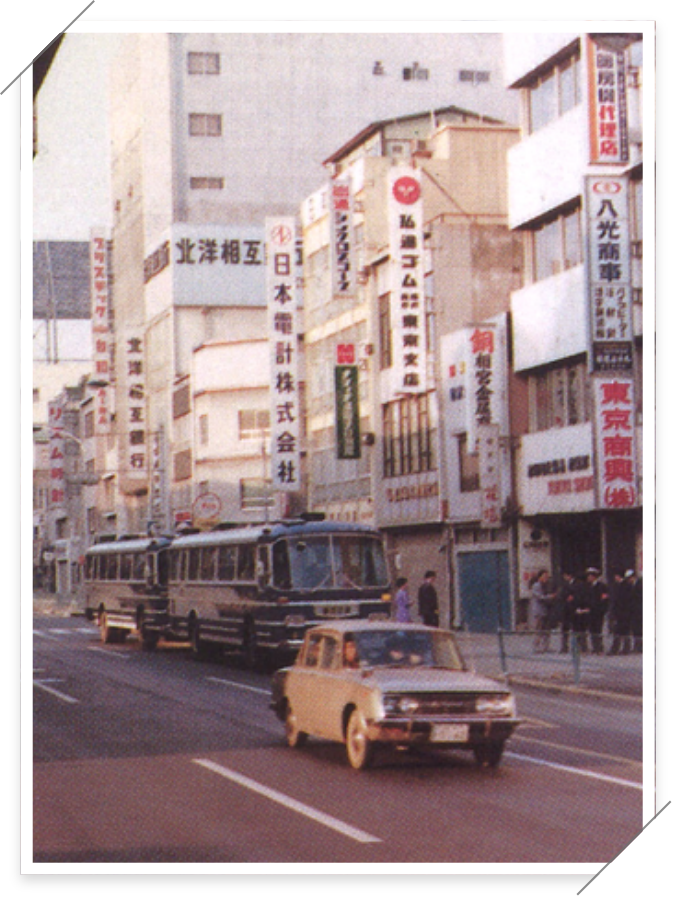

Establishment of Denkei Co., Ltd., specialized in sales of spare parts
Around 1970, the booming economy had come to an end. We took on the challenge of exploring new possibilities by founding a subsidiary. In April 1970, with a full investment, we launched Denkei Co., Ltd. as a distributor of mechanical components such as connectors of Daiichi Electronics Industries Co., Ltd. In doing so we gave rise to hope while wiping out the bleak atmosphere overcast throughout Japan, taking the first step toward expanding our distribution business.
Expansion of bases from east to west under the oil crisis
In the mid 1970s and 1980s, it can be said was a turning point of Japan’s economy. First, in October 1973, the oil crisis, triggered by the fourth Middle East war, spread quickly througout the entire world. This was the year of the first oil crisis. After this, the Japanese economy entered a period of strong yen and low growth, and the business environment of each enterprise became increasingly challenged.
Tama Sales Office was established in April 1973, just before the first oil crisis. After just four years back, the head office was relocated to Ueno. By this time the number of employees had increased and the office space became cramped. In addition, it was becoming difficult for the head office alone to look after users expanding throughout the Tokyo area. Therefore, with expectations of further business expansion it was decided to inaugurate a sales office in Tama, a western suburb of Tokyo.
Following the opening of Tama Sales Office, Ibaraki Sales Office was opened in Mito City in March 1974. Built at the site of Tokyo National Electronics Measurement Co., Ltd. Users included engineering high schools in Ibaraki, the engineering faculty of Ibaraki University, Ibaraki National Engineering High Technical School (former Katsuta Kosen) and Mito Engineering High School which has a long history. In addition, when electric divisions were newly established in engineering high schools such as Tsuchiura, Hitachi, Takahagi and Tamatsukuri, they became new customers. Although most of users had transactions before the Ibaraki sales office was established, after the local sales office was established, the company was able to provide customer support more closely. In November 1975, the office in Mito was relocated to Tsuchiura. This was due to the relocation of the research academy city, where large-scale demand was expected. This was carried out about two years earlier than planned. Tsuchiura sales office was located just in front of the Tabacco Monopoly Public Corporation in front of the railway station. Even after moving to Tsuchiura, the salesforce called each user in Mito while spending about one hour driving through an expressway.
To the center of the Chukyo Economy Zone
The oil crisis that began in 1973 brought staggering increases in prices and labor costs. In the next year, the deteriorating power situation caused TV broadcasting to cease late at night. In 1975, oil prices rose again, quadrupling the price level before the oil crisis. Looking at our turnover in FY 1973 (the 28th fiscal year), it was close to 2.6 billion yen. In the following FY1974 (29th fiscal year), it was over 3.3 billion yen. At that time, there had been Hamamatsu Sales Office established in 1969 as a base in the Chubu region. It had many users in Nagoya as well as the adjacent area. If you were far away from customers, you would have more opportunities to use your phone in business. However, in the wake of the oil crisis, users who dealt with us were prohibited from calling outside the prefecture, even if they contacted us for business purposes. When receiving POs, they used a round-trip postcard to economize. This was not limited to our customers, but was a protection against the oil crisis that occurred all over the country. It can be said without question the economic damage caused by the oil shock to Japan was significant. It was impossible to provide satisfactory services to users as customers, had we stood still. Thus, Nagoya Sales Office was born.
Full-scale PC-related businesses
In October 1976, we began full-scale handling of PCs and peripherals in response to the demands of the times. Analog computers, relay-type calculators and mini-PCs were sold to research institutes for the analysis of measurement data. With the launch of PCs manufactured by Tandy Corporation of US in Japan we were convinced, as an analysis and recording tool in the field of electronic measurement, that it would become an indispensable product in the future. We also understood that the potential of the product as a control device in the field of factory automation was immeasurable. Thus, we implemented policies to enhance the handling of peripheral equipment which carries on to this day.
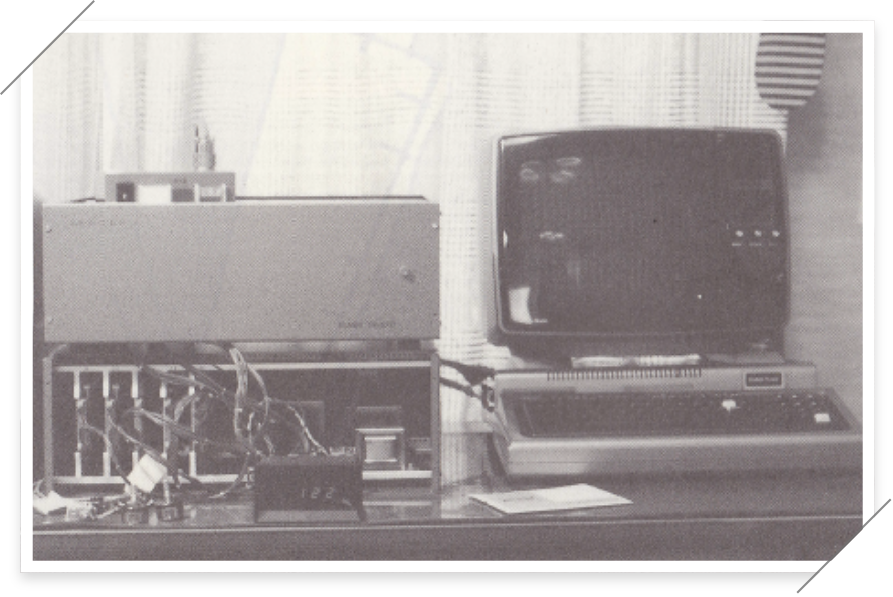
Systemized equipment using Tandy’s personal computer

Opened the second base in Kanagawa, Atsugi Sales Office
Japan was again hit by the second oil crisis in 1980, when the scars caused by the oil crisis that occurred suddenly in 1973 still remained. As a measure to prevent anticipated inflation the government raised interest rates to record-high levels . As a result, the economy began to show signs of stagnation. While the government took measures to stimulate demand in anticipation of the stabilization of prices and the persistence of the yen’s appreciation, it did not lead to a recovery in the economy.
On the other hand, the electronics industry remained brisk despite the economic environment. It was also a time when the demand for home video was rapidly expanding in the home appliance field. At that time, Sony was looked after by the sales department at the head office, as the Sony business was becoming very active. Although Yokohama Sales Office had already been established in Kanagawa Prefecture, Atsugi Sales Office was opened in September 1980 with the aim of providing close service to Sony’s Atsugi Plant and expanding business in that area.
The sales office was on the way from Hon-atsugi railway station to the Sony plant. We were eager to take on any task requested by customers. Even in the event of an oil crisis, if asked to do so, during times of shortages of goods we would go all the way to Akihabara to buy a variety of items the customer needed.
Building a new base in Utsunomiya
Around this time, demand from the engineering high school in Tochigi was declining. On the other hand, POs from private companies and universities, such as Nippon Signal Co., Ltd.’s Utsunomiya Plant, Utsunomiya University, Sony and other private companies gradually began to be revitalized. By then, although the company had opened sales offices in Saitama and Ibaraki as bases in charge of users in Kanto region, these offices alone made it difficult for the company to provide thorough service to local and Tochigi prefectural users.
In October 1981, therefore, a sales office was established in Utsunomiya.
Focusing on users in Chiba Prefecture
At that time, there were factories such as Sony Togane Co., Ltd. and Sony Kisarazu Co., Ltd. in Chiba, as well as many other clients like schools and the government agencies such as Chiba Institute of Technology, Chiba University, Nihon University and the National Institute of Radiological Sciences. Until a local sales office was established, salespersons at the head office would call on customers not only in Tokyo but also the users in other regions. Needless to say, this was also the case for Chiba. However, as work loads increased, it was more convenient for customers as well as employees to have a sales office in an adjacent area rather than go back and forth from Tokyo with such frequency.
In the light of above circumstance, Chiba Sales Office was opened in February 1983 with a focus on our basic policy of building close ties with local communities.
Birth of Tokyo South Sales Office
Tokyo Sales Office originally dealt with 23 wards by dividing them into north and south. However, there was much more work in the southern sections because it included the Keihin Industrial Zone. In order to expand its customer-oriented service business, it became necessary to establish a new sales office in the southern area. Accordingly, in March 1985 we established Tokyo South Sales Office as a base in charge of Ota-ku, Meguro-ku, Shinagawa-ku and Sony-related businesses, where users were more densely located..
Construction of the Atsugi Office and Technical Center
In April 1985, Technical Center and Training Center were opened while Atsugi Office was established in Atsugi City, Kanagawa Prefecture. A four-story office building was constructed in the vicinity of Atsugi railway station. Atsugi Sales Office was relocated on the first floor to create a technical center on the second floor, a training center on the third floor, and accommodation facilities on the fourth floor.
Since that time, ready-made equipment was unable to fulfill user’s requirements, fueling an increase in business where custom-made products were needed. We enhanced engineering departments dealing with custom-made products, and inaugurated a technical center, putting in place a system for designing and manufacturing. There were also many businesses where a single systemized measurement was delivered by combining measuring instruments from different manufacturers.
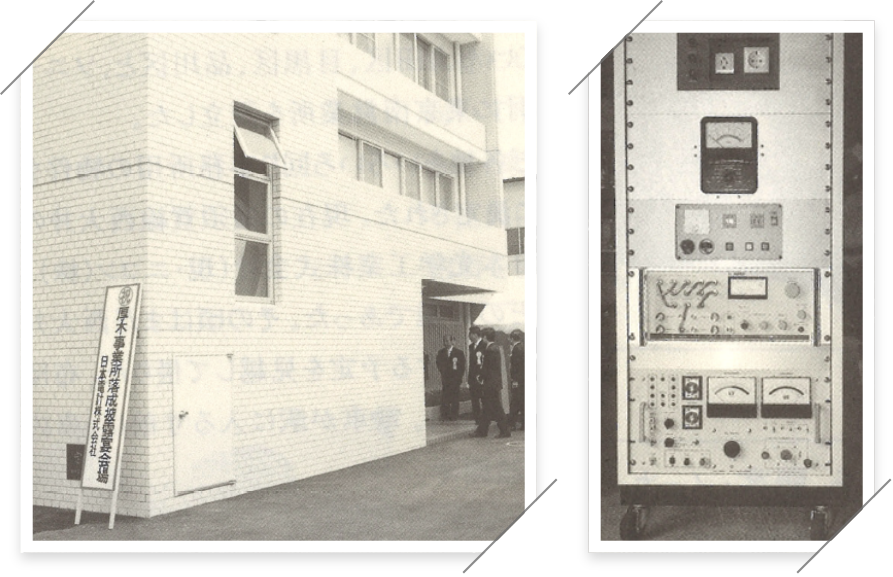
Left: Atsugi Office/Right: Measurement device manufactured by us
The first step into the western Japan region, Kyoto
During the nine years since the opening of the Nagoya Sales Office, we became focused on extending our footprint into the western Japan area. Coincidentally, one of our users requested we have a base in their vicinity. In response, in July 1985, we opened Kyoto Sales Office as the first base in the western Japan region.
Finding our way to Koshinetsu region
A dozen of years had passed since the establishment of Tama Sales Office. Accordingly, we repeatedly relocated our sales offices in search of more space to accommodate the increase in employees. Although it was easy to physically widen our sales offices, we did not do so. As a more strategic means, we pushed forward to Yamanashi. In November 1985, with the aim of extending our reach westward with Yamanashi as the base, we opened Yamanashi Sales Office located within a 10-minute drive from Kofu railway station toward Chuo Highway.
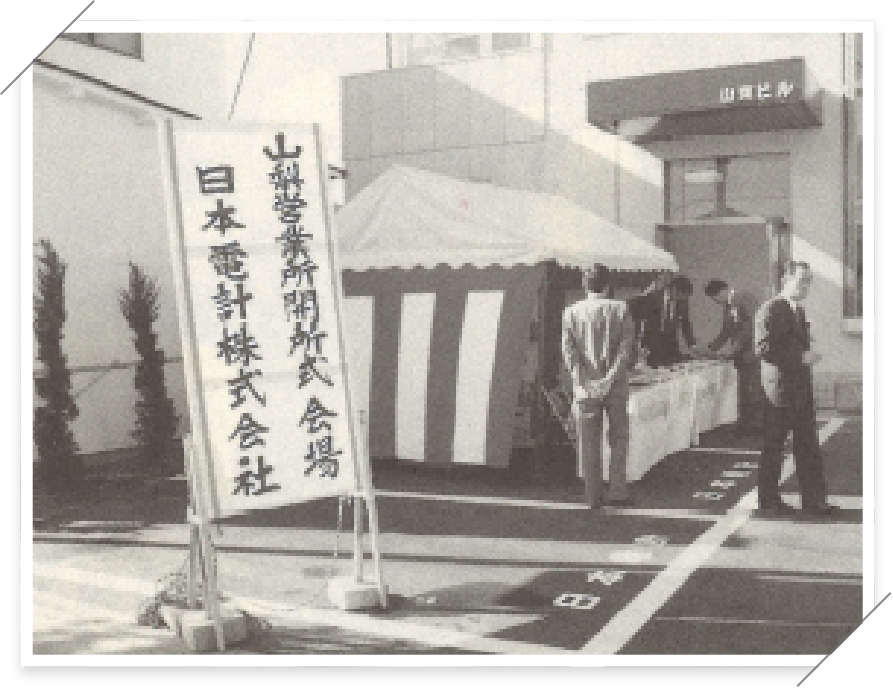
Opened Inventory Center and relocation of Yokohama Sales Office
Yokohama Sales office, as Nihon Denkei’s first sales base, had been a tenant for a long time since its opening and was getting cramped. The company purchased about 660 sq. meter of land in Tsurumi and constructed an Inventory Center in October 1988 along with the relocation of Yokohama Sales Office. The Inventory Center in Tsurumi as a logistics base had become a large-scale one. In response to the demands from users for even faster logistics, the company established the Inventory Center in that location with the purpose of establishing a system for immediate delivery and improving logistics efficiency.
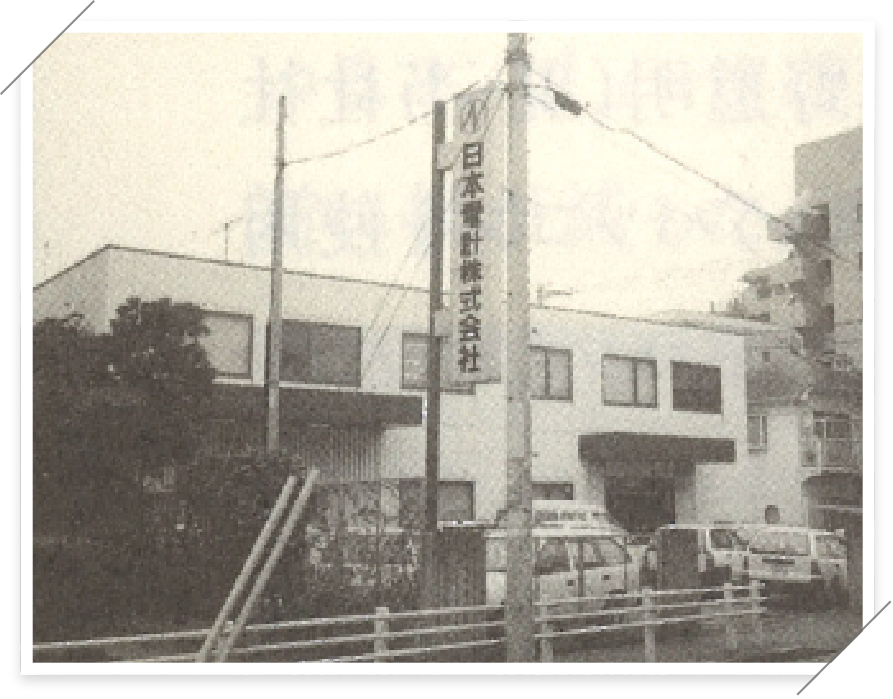

First ever overseasl branch in Singapore
There is no way to survive competition against global companies in the global market without lowering labor costs. Especially since production methods and material costs remained the same. During that time, many companies in Japan as well as the rest of the world shifted their production bases to Southeast Asia, where labor costs were inexpensive, and devoted their full efforts to reducing production costs. Within this backdrop we opened a branch in Singapore in September 1990 to serve as a sales base for customers throughout Southeast Asia. The distinctive feature of this branch was that it also performed maintenance (repairs and calibrations) that we did not do in Japan. We assigned three Japanese individuals from our Tokyo head office to the branch, including engineers along with six others employed locally. Thus we started to run the business in Singapore with a workforce of nine people in total.
The reason for setting Singapore as the first base for expanding global business was that many of our Japan-based major customers had their bases in Singapore and requested we come. The most important reason being a need for us to conduct maintenance. Moreover, Japanese companies for quite some time had been requesting we expand overseas. Whereas some 90% of the electronic measuring instruments we handled were subject to COCOM regulations. One of the factors behind our entry into Singapore was the start of gradual easing of the COCOM regulations. We would take this opportunity to further deploy into Malaysia, Thailand and other countries.
Over-the-counter share
Just before the bursting of the so-called “bubble economy”, we began preparing for an over-the-counter offering. Signs of bursting began to appear everywhere. Thus, there were many companies having to forgo over-the-counter listings. Today, it is an era in which we can be listed in the stock market even if the current business performance is not in a good shape. The company now looks to have unlimited potential. However, at that time there was a tacit standard that companies that did not perform well could not go public. In other words, there was the perception that OTC public companies were “reserve forces for listed companies”. There were difficulties in going on to the OTC market if, in due course, we were unable to be listed in the stock market.
The most difficult thing about the OTC (or IPO) was preparing documents to be submitted to securities companies and the Finance Bureau of the Ministry of Finance. This was because the terminology and the format of the documents were all imperatively fixed and quite different from that of our day-to-day business. Three years after preparations began, the company made OTC on October 8, 1991, with concerns as well as expectations about the price at the time of the initial offering.

The day after the over-the-counter offering, the first price is reported (from the stock market newspaper, October 9, 1991)
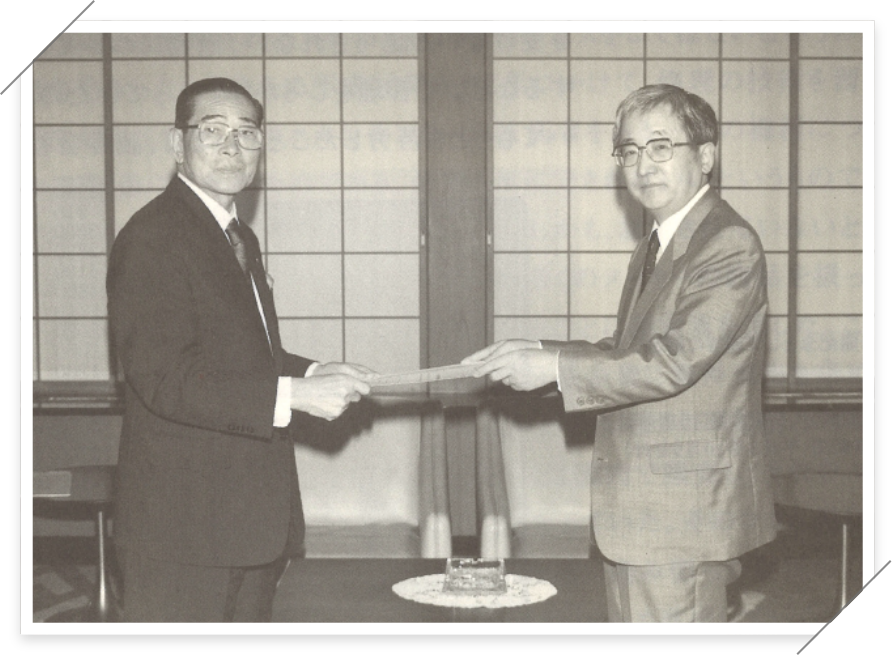
Presentation ceremony for the new registration certificate for over-the-counter trading
Opened sales offices in Nagano and Matsumoto
One of our employees who worked for Denkei in the past became independent and established his/her own business for trading measuring instruments in Nagano Prefecture. In mid-1991, however, we received requests from this person to acquire the entire company, including employees. As we were coincidentally seeking to deploy into Nagano Prefecture at that time, we made the decision to accept the above offering in July 1992. Simultaneously opening Nagano Sales Office and the Matsumoto Sales Office.
Subsidiaries in Malaysia and Thailand
Numerous Japanese-affiliated companies also looked towards Malaysia, of which our Singapore branch was in charge of taking care of and providing services through business trips. However, in the form of a business trip, it was only sporadic support. Customers wanted us to be there to help them whenever needed. In July 1996, the company established a subsidiary in Kuala Lumpur, Malaysia, to fulfill the customers’ requirement.
In Thailand as well, there were a number of factories, Japan-based companies, where we provided before & after-sales services on a frequent basis. At a time when Sony created a huge plant for car audio equipment in Thailand, we received a voluminous PO in Japan for the plant in Thailand. In response to the customer’s requirements we established a subsidiary in Bangkok in May 1997.
Toward Chinese Market
Similar to Southeast Asia, because of low production costs and the fact that it’s better to produce the product in the marketplace, Japan-based companies deployed into Mainland China. The primary reason Denkei seeked to locate in China was due to our domestic customers having increased their presence there. Despite the fact that we have had businesses with China before Malaysia and Thailand, it was difficult for us to take the plunge with having a subsidiary in China. The system there did not appear to be transparent.
Furthermore in China, it was also challenging for the business model of a trading firm like us to obtain a business license. Plant constructions and technical transfer by manufacturing companies, for instance, were welcome because they boosted employment and raised the level of local technicians. Whereas trading firms like us were not regarded as a form of technology transfer. Accordingly, we could establish a liaison office only, and could not conduct sales activities. Therefore, it was just about the business of dissemination and curation of information. Due to these circumstances, while conducting sales activities in Japan, it was decided to set up a liaison office in order to have contact with customers in China.Thus, in July 1996, the company established its first liaison office in Tianjin, and then expanded to Shanghai, Dalian, and Shenzhen.
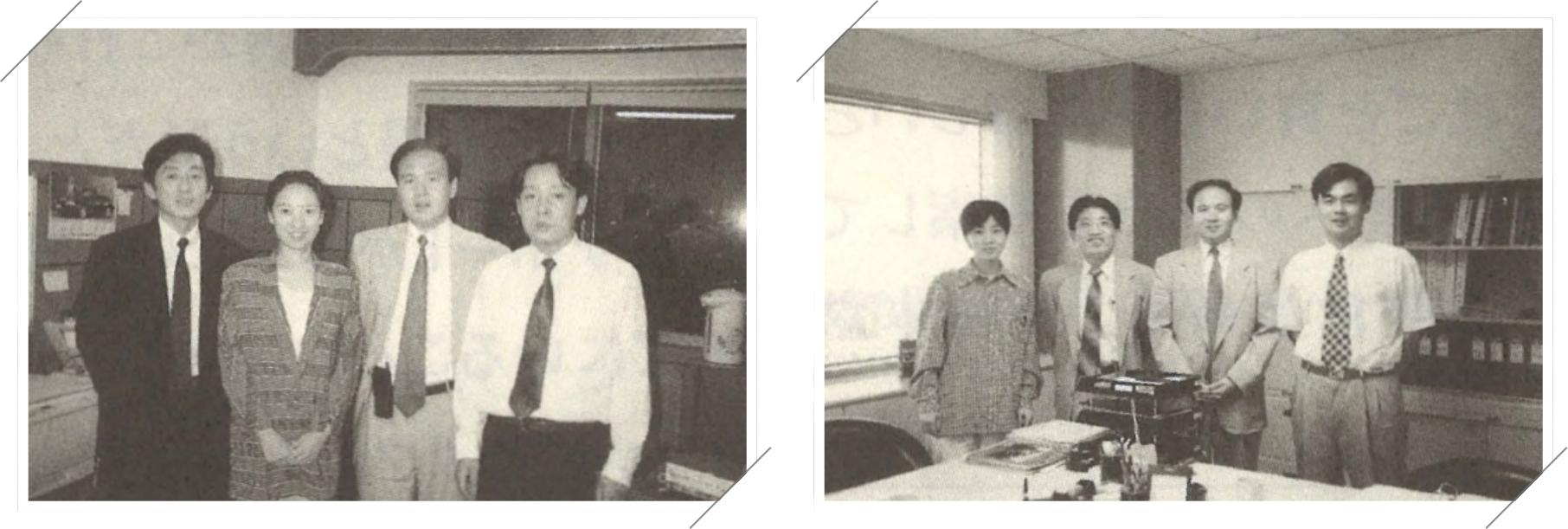
Left: Tianjin Liaison Office at its inauguration/Right: Shanghai Liaison Office at its inauguration
For the next half century
After having led Nihon Denkei since its foundation and half a century since starting its maiden voyage from a 5 sq.meter store in Kanda-Suda-cho in 1950, Takada, we are determined to hand over the baton to the next generation along with the arrival of a new era.
In April 1999, Hironobu Takada, the first president, was appointed as Chairman of the Board, while Michiaki Kohno, then the vice president, was appointed as the second president cum representative director.
Hironobu Takada’s presidency spanned as long as 48 years and 7 months.
Having grown up as a trading firm specializing in electronic measuring instruments, we have now reached the point of being a leading company with the top market share in the industry. Although the number of customers, the number of suppliers, the items handled, capital stock, and the number of employees have increased dramatically in terms of the size of enterprise, there has been something which remains unchanged since the company’s foundation, our corporate philosophy. The main pillar of our activities is to be a “Technical Partner” for both our customers and manufacturers. We will always strive to economize; we will focus on employee education. We will actively strengthen our corporate structure and we will establish a system that can fulfill customer’s needs and wants. Through these efforts, we will prosper, cooperate and contribute to the development of the cutting-edge technologies of our customers and manufacturers. Those philosophies have also been the persistent spirit of the entrepreneur Hironobu Takada.
Marking its 50th anniversary
Half a century with measuring instruments












